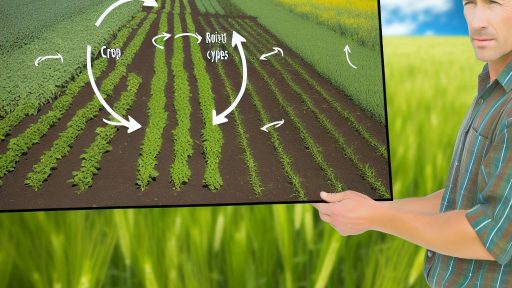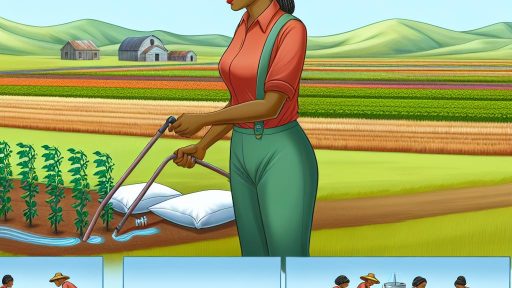Introduction to Crop Rotation and Its Importance for Soil Fertility
Crop rotation significantly enhances soil fertility over time.
This practice involves alternating different crops in a designated area across seasons.
It helps break pest and disease cycles, promoting healthier crops.
Additionally, crop rotation improves soil structure and nutrient availability.
Different crops utilize soil nutrients in unique ways, preventing nutrient depletion.
For instance, legumes fix nitrogen in the soil, enriching it for subsequent plants.
Crop rotation also reduces the reliance on chemical fertilizers and pesticides.
This eco-friendly strategy minimizes the risk of soil erosion and degradation.
Furthermore, it supports a diverse ecosystem by attracting beneficial insects.
Farmers can thus ensure higher yields over the long term through rotation.
A well-planned rotation schedule can increase resilience against climate variability.
Implementing crop rotation is vital for sustainable agricultural practices.
Farmers like Michael Anders have successfully adopted this approach on their farms.
They report improved soil health and increased crop production.
Understanding the principles of crop rotation is essential for all growers.
Transform Your Agribusiness
Unlock your farm's potential with expert advice tailored to your needs. Get actionable steps that drive real results.
Get StartedUnderstanding Soil Health
Key Factors Influencing Fertility
Soi health is fundamental to agricultural productivity.
It influences crop yield, nutrient availability, and sustainability.
Multiple factors play a role in determining soil fertility.
Firstly, soil organic matter is crucial for nutrient retention.
High levels of organic matter enhance soil structure.
Additionally, it improves moisture retention and aeration.
Next, soil pH affects nutrient availability.
Most crops thrive in slightly acidic to neutral soil.
Extreme pH levels can lead to nutrient deficiencies.
Furthermore, microorganisms are vital for nutrient cycling.
They decompose organic matter and release nutrients back into the soil.
Healthy microbial activity fosters a thriving ecosystem.
Mineral content also significantly impacts soil fertility.
Essential minerals include nitrogen, phosphorus, and potassium.
These nutrients support plant growth and development.
Another important factor is soil texture.
Soil texture influences water retention and drainage capacity.
Clayey soils retain more water, while sandy soils drain quickly.
Therefore, understanding the balance is essential for optimum fertility.
Moreover, crop rotation can enhance soil health.
Diverse crops replenish different nutrients in the soil.
This practice minimizes pest and disease buildup.
Integrating cover crops can also benefit soil structure.
Cover crops prevent erosion and improve organic matter levels.
Showcase Your Farming Business
Publish your professional farming services profile on our blog for a one-time fee of $200 and reach a dedicated audience of farmers and agribusiness owners.
Publish Your ProfileHealthy soil is the foundation of successful agriculture.
By understanding its key factors, farmers can enhance long-term fertility.
Basic Principles of Crop Rotation
Understanding Crop Rotation
Crop rotation involves alternating different crops over seasons.
This technique improves soil health and fertility.
Moreover, it helps in breaking pest and disease cycles.
Farmers actively choose crops based on their nutrient needs.
As a result, they maximize the soil’s productivity over time.
What to Rotate
Farmers typically rotate legumes, grains, and vegetables.
Legumes, like beans and peas, enrich soil with nitrogen.
Grains, such as wheat and corn, absorb different nutrients.
Including root vegetables also aids in soil structure.
By mixing these crops, farmers can enhance soil diversity.
Benefits of Rotation
Crop rotation promotes better soil structure and composition.
This method helps in reducing soil erosion over time.
It also minimizes the reliance on chemical fertilizers.
Consequently, farmers experience increased resilience to climate change.
Ultimately, the environment benefits from healthier farming practices.
Implementing a Rotation Plan
A successful rotation plan requires careful planning.
Farmers should consider local climate and soil conditions.
They can create a multi-year crop rotation schedule.
By tracking crop yields, they can adapt their strategies.
Regular evaluation leads to improved long-term outcomes.
Future Considerations in Sustainable Farming
Adopting crop rotation reflects a commitment to sustainability.
It not only boosts soil fertility but also enhances biodiversity.
Looking ahead, farmers must remain flexible with their plans.
As conditions change, so too should their cropping strategies.
The ultimate goal is to achieve balanced and productive farming.
Delve into the Subject: Conservation Tillage Tools Every Farmer Should Know
Common Crop Rotation Systems
Understanding Crop Rotation
Crop rotation involves alternating different crops on the same land over time.
This technique breaks pest cycles and improves soil health.
Farmers implement various rotation systems based on their specific needs.
Legume and Cereal Rotation
Legumes, such as beans or peas, enrich the soil with nitrogen.
Cereals, like wheat or corn, benefit from the previous legume crop.
This rotation improves soil fertility and crop yields significantly.
Additionally, it reduces the need for synthetic fertilizers.
Three-Year Rotation System
This system usually includes three different crops grown in succession.
For example, corn, soybeans, and wheat can be planted in alternating years.
This method enhances biodiversity and soil nutrient management.
Moreover, it helps in mitigating soil erosion and nutrient depletion.
Cover Cropping Rotation
Cover crops, like clover or rye, are planted during off-seasons.
Showcase Your Farming Business
Publish your professional farming services profile on our blog for a one-time fee of $200 and reach a dedicated audience of farmers and agribusiness owners.
Publish Your ProfileThey protect the soil from erosion and suppress weeds effectively.
Cover crops also add organic matter back into the soil when plowed under.
Furthermore, they enhance soil structure and water retention.
Benefits of Crop Rotation
Crop rotation provides numerous benefits to sustainable agriculture.
- It improves crop diversity.
- It reduces the risk of soil degradation.
- It enhances soil resilience and fertility.
- It helps manage pests and diseases effectively.
Ultimately, crop rotation fosters a healthier farming ecosystem.
You Might Also Like: Using Terracing to Improve Water Conservation on Slopes
Legume Inclusion in Crop Rotation: Nitrogen Fixation and Soil Enhancement
Understanding Legume Role in Crop Rotation
Legumes play a crucial role in sustainable agriculture.
They enhance soil fertility through nitrogen fixation.
This process involves converting atmospheric nitrogen into a usable form.
Farmers can benefit from rotating legumes with other crops.
As a result, they can reduce reliance on synthetic fertilizers.
Mechanism of Nitrogen Fixation
Nitrogen-fixing bacteria form a symbiotic relationship with legume roots.
These bacteria are housed in root nodules.
During this interaction, plants receive nitrogen in exchange for carbohydrates.
This natural reinforcement promotes healthy plant growth.
Additionally, it enhances soil microbial activity.
Benefits of Using Legumes in Rotation
Incorporating legumes leads to several agricultural advantages.
- Greater soil fertility.
- Improved soil structure and health.
- Enhanced biodiversity in crop systems.
Moreover, legumes help break pest and disease cycles.
This contributes to overall crop resilience.
Recommended Legumes for Crop Rotation
Farmers should consider various legume options for rotation.
- Soybeans are popular for their high protein content.
- Peas are excellent for cool climates.
- Chickpeas thrive in drier areas.
Each legume has unique benefits and growth requirements.
Farmers can choose based on local conditions and crop goals.
Best Practices for Legume Inclusion
Effective management ensures optimal legume benefits.
Rotation timing is crucial for maximizing nitrogen benefits.
Farmers should plant legumes early in the season.
This strategy allows proper nitrogen release for subsequent crops.
Moreover, integrating cover cropping can prevent soil erosion.
Implications for Long-Term Soil Health
Utilizing legumes in crop rotation promotes long-term soil health.
This strategy leads to sustainable agricultural practices.
Farmers can achieve economic benefits through smarter cropping choices.
Ultimately, legume integration is vital for future food security.
You Might Also Like: Permaculture Farm Planning Strategies For Optimal Yield
Impact of Continuous Monoculture: Consequences for Soil Health
Depletion of Nutrients
Continuous monoculture leads to the depletion of essential nutrients in the soil.
For instance, crops like corn exhaust nitrogen levels over time.
This results in reduced fertility and soil degradation.
Farmers may face declining yields as nutrients become scarce.
Increased Pest and Disease Pressure
Monoculture practices can increase pest and disease outbreaks.
Without crop diversity, pests adapt and proliferate rapidly.
Over time, resistant pests can become major threats to crops.
This can lead to increased pesticide use, further harming soil health.
Showcase Your Farming Business
Publish your professional farming services profile on our blog for a one-time fee of $200 and reach a dedicated audience of farmers and agribusiness owners.
Publish Your ProfileSoil Structure and Erosion Issues
Monoculture can negatively affect soil structure and stability.
Repeated planting of the same crop weakens root systems.
As a result, soils become more susceptible to erosion.
This loss of soil can diminish land productivity significantly.
Microbial Diversity Reduction
Continuous cropping reduces the diversity of soil microorganisms.
Diverse microbial communities are crucial for healthy soil ecosystems.
These organisms help with organic matter decomposition and nutrient cycling.
A lack of diversity can ultimately hinder soil health and resilience.
Water Management Challenges
Soil health directly influences water retention and drainage capabilities.
Monoculture often results in poor water infiltration over time.
This can lead to either waterlogging or drought conditions for crops.
Managing water efficiently becomes increasingly difficult under these circumstances.
Long-Term Sustainability Risks
The reliance on monoculture practices poses long-term sustainability risks.
Farmers may face significant economic pressures due to reduced yields.
Environmental degradation can also threaten the farming ecosystem.
Ultimately, this approach compromises food security for future generations.
Gain More Insights: Enhancing Pest Control through Crop Rotation Methods

Best Practices for Implementing Crop Rotation on Different Farm Types
Understanding Crop Needs and Soil Health
Each crop has unique nutrient demands and soil preferences.
Recognizing these needs supports optimal growth and soil health.
Regular soil testing provides valuable insights into nutrient levels.
Adjusting crop selections based on soil conditions enhances fertility.
Developing a Rotation Plan
Create a detailed crop rotation plan tailored to your farm.
Incorporate diverse crops to break pest cycles effectively.
Include legumes in your rotation to improve nitrogen levels.
This practice promotes biodiversity while reducing soil depletion.
Managing Pest and Disease Pressure
Rotate crops to interrupt pests’ and diseases’ life cycles.
Choose resistant varieties to further reduce risks.
Consider companion planting to enhance pest control naturally.
Constant vigilance helps identify emerging pest problems quickly.
Farm Size Considerations
Smaller farms can focus on diverse rotations in limited space.
Smaller plots allow for experimentation with different crops.
Larger farms may benefit from larger-scale rotations and monoculture management strategies.
Efficient planning maximizes the usability of available land.
Understanding Local Climate Conditions
Climate significantly influences crop choices and rotation strategies.
Factor in rainfall patterns when planning your rotations.
Some crops thrive better in specific climates compared to others.
Adapting to local weather patterns ensures successful crop yields.
Marketing and Economic Considerations
Evaluate market demand for crops before finalizing your rotation.
Product prices impact profitability and planting decisions.
Optimize your rotation strategy based on upcoming market trends.
Showcase Your Farming Business
Publish your professional farming services profile on our blog for a one-time fee of $200 and reach a dedicated audience of farmers and agribusiness owners.
Publish Your ProfileStaying informed about economic conditions enhances decision-making.
Challenges and Solutions in Adopting Crop Rotation Techniques
Understanding Common Challenges
Many farmers face challenges when implementing crop rotation techniques.
One major challenge is the lack of knowledge about appropriate crop combinations.
Additionally, changing established farming habits can be difficult.
Weather conditions can also pose significant obstacles.
For instance, unpredicted weather events may disrupt planned rotation schedules.
Moreover, farmers might worry about short-term yields during the transition.
Education and Training Opportunities
Education plays a crucial role in overcoming these challenges.
Farmers can benefit from training sessions or workshops on crop rotation methods.
Local agricultural extension services often provide valuable resources.
Furthermore, online courses can offer flexible learning options.
Networking with other farmers can inspire innovative rotation strategies.
Effective Planning Strategies
Developing a well-structured plan can alleviate many concerns.
Farmers should consider their specific soil types and local climate conditions.
Implementing trial runs can help assess the effectiveness of different rotations.
Moreover, documenting results can facilitate future adjustments.
Additionally, using cover crops may help improve soil quality during off-seasons.
Utilizing Technological Advances
New technologies can enhance the effectiveness of crop rotation.
Precision agriculture tools can help monitor soil health and crop performance.
Furthermore, data analytics can guide farmers in making informed decisions.
Mobile applications can assist in planning and tracking crop rotations.
Ultimately, embracing technology can lead to increased productivity.
Encouraging Community Support
Building a supportive community can ease the transition to crop rotation.
Local farmer cooperatives can share best practices and resources.
Collaboration with agricultural researchers can foster innovative solutions.
Community events can promote shared knowledge and experiences.
Ultimately, a united effort can help create a resilient farming environment.
Case Studies: Successful Crop Rotation Strategies from Around the World
North America – The Corn and Soybean Rotation
Farmers in the Midwest United States leverage a corn-soybean rotation.
This technique enhances soil fertility and disrupts pest cycles.
Studies show significant yield improvements over continuous cropping.
Additionally, this method reduces the need for synthetic fertilizers.
Europe – The Three-Crop Rotation
In parts of France, farmers utilize a three-crop system.
This includes wheat, barley, and legumes, promoting nutrient cycling.
Such rotations lead to better soil structure and increased organic matter.
Farmers have noted sustained yields and reduced weed pressure.
Africa – Intercropping for Soil Health
In East Africa, farmers practice intercropping with maize and beans.
This method not only boosts food production but enhances soil fertility.
Beans fix nitrogen in the soil, benefiting subsequent maize crops.
Additionally, this approach improves biodiversity and resilience to climate change.
Asia – Rice and Fish Farming
In Vietnam, integrating rice with fish farming has gained popularity.
Showcase Your Farming Business
Publish your professional farming services profile on our blog for a one-time fee of $200 and reach a dedicated audience of farmers and agribusiness owners.
Publish Your ProfileThis system utilizes fish to control pests while enriching the water with nutrients.
Studies highlight increased rice yields and improved ecosystem health.
Moreover, farmers report enhanced income from both rice and fish sales.
South America – Crop Diversification
Brazilian farmers employ diverse crop rotations including soybeans and millet.
This strategy results in improved soil organic carbon and enhanced biodiversity.
Farmers benefit from reduced soil erosion and effective pest management strategies.
Furthermore, crop diversity minimizes risks associated with monoculture.
Future Trends in Crop Rotation
Innovations in Crop Rotation
The agriculture industry continuously introduces innovative practices for crop rotation.
These techniques enhance soil fertility and resilience.
For instance, farmers use cover crops to protect soil during fallow periods.
This practice improves organic matter and nutrient availability.
Moreover, precision farming tools help farmers optimize their rotation schedules.
Data-driven approaches allow for more informed decisions regarding crop choices.
Sustainable Practices Shaping the Future
Sustainability remains a crucial focus within crop rotation systems.
Farmers increasingly adopt techniques that replenish rather than deplete soil resources.
For example, integrating legumes in crop rotations adds vital nitrogen to the soil.
This not only reduces the need for chemical fertilizers but also boosts crop yields.
Additionally, practicing agroecology fosters biodiversity on farms.
This leads to improved pest control and healthier ecosystems.
Adoption of Technology in Crop Management
Technology plays a significant role in modernizing crop rotation practices.
Farmers employ soil health monitoring tools to track nutrient levels.
Furthermore, mobile apps provide farmers with timely information on crop management.
Such advancements increase efficiency and yield potential.
Remote sensing technologies help in monitoring crop growth and health.
This facilitates timely interventions and smart resource allocation.
Collaboration and Knowledge Sharing
Collaboration among farmers, researchers, and educational institutions drives innovation.
Sharing knowledge accelerates the adoption of effective rotation strategies.
Workshops and extension services play a vital role in this exchange.
As a result, farmers implement best practices based on successful case studies.
This communal learning fosters resilience and sustainability in farming systems.
Regulatory Support for Sustainable Practices
Governments are increasingly recognizing the need for sustainable crop practices.
Regulatory frameworks support farmers adopting eco-friendly methods.
Incentives and subsidies encourage the use of diverse cropping systems.
This ultimately leads to improved long-term soil fertility.
Policies that promote sustainable agriculture contribute to food security as well.
Additional Resources
Optimizing sustainable agriculture: A comprehensive review of …
Long-Term Evidence Shows that Crop-Rotation Diversification …




